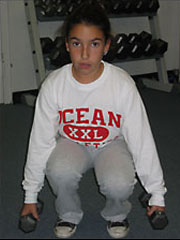The term isometrics refers to exercise protocols during which no shortening or lengthening of the muscle occurs. Traditional isometric protocols typically involve the sudden application of a maximal contraction lasting 10 to 15 seconds, usually performed against an immovable object or another muscle group. Some protocols involve holding a posture for a longer period of time using the subject’s own body weight as resistance (wall squats, planks, various yoga postures).
Over the past few decades various high intensity training isometric protocols have been developed. These vary considerably in duration, from less than 6 seconds in John Little’s Max Contraction training, to 90 seconds in Ken Hutchins’ Timed Static Contraction protocol. Some popular high intensity training methods, such as the late Mike Mentzer’s Static Holds and John Little’s Omega Sets, incorporate both an isometric and dynamic or “isotonic” component, usually involving an isometric contraction followed by a partial or full range negative.
Basic Descriptions of Popular High Intensity Training Isometric Protocols
Mike Mentzer’s static holds involve an isometric contraction in the “fully-contracted” position of a single-joint or compound pulling exercise or the mid-range position of a compound pushing exercise, using a weight the subject can hold for between 8 and 12 seconds for the upper body, or 15 to 30 seconds for the lower body. When the subject can no longer hold the weight motionless, they perform a slow negative.
John Little’s Max Contraction protocol is similar to Mike Mentzer’s static hold, but involves a much shorter (0.25 to 6 second) isometric contraction, and is only used in the fully-contracted position of a single-joint or rotary exercise. When performed as part of an Omega Set, the Max Contraction may be repeated for several repetitions.
Ken Hutchins’ timed static contraction protocol involves a 90-second isometric contraction against a fixed or immobile source of resistance, consisting of three 30-second segments of gradually increasing effort. Subjects are instructed to exert a “moderate” effort during the first 30 seconds, an effort that is almost as hard as they dare during the second 30 seconds, and to contract as hard as they dare for the last 30 seconds, then to gradually reduce effort after the full 90 sec0nds.
The subject is instructed to contract as hard as they dare rather than as hard as they can to remind them to be cautious since it is possible to produce very high levels of force.
Advantages
If a subject is unable to perform an exercise dynamically due to an injury or joint deformities or if they experience pain or irritation in certain portions of the range of movement, an isometric contraction performed in a position where the subject does not experience pain or irritation is an effective alternative.
Subjects suffering from neck problems which are exacerbated by various dynamic exercises for the upper body can often perform those exercises using timed static contraction with little or no irritation to the neck.
Since very little skill or motor control is necessary, subjects with too poor a level of motor ability to perform dynamic exercise in a controlled manner can safely perform isometrics.
Many timed static contraction exercises require no special equipment and can be performed using one’s own body, a wall, or common items such as chairs, balls and belts. Such exercises make it possible for those without access to exercise equipment to directly address certain muscular structures that are only indirectly addressed using traditional bodyweight exercises, possibly as a pre-exhaust for those exercises. One example of this would be to perform a timed static contraction chest fly, contracting against a ball held between the elbows to address the pectorals, which could be performed as a pre-exhaust for push-ups.
Isometric protocols can often be performed effectively on equipment which possesses too much friction or improper resistance curves for use with dynamic protocols.
Disadvantages
Isometric protocols provide no stretching and do little to improve the flexibility of the muscles worked. This problem is easily solved by performing separate stretching exercises for those muscles if required (only a few muscles can actually be stretched).
Due to the greater blood pressure (BP) elevation possible with isometric exercise and especially during exercises involving gripping, extra caution is necessary for subjects with high BP or conditions that may be exacerbated by significant BP elevation. Proper breathing is absolutely essential to minimize BP elevation, specifically not performing Val Salva’s maneuver.
Isometric exercise protocols may produce strength increases specific to the position or joint angle trained, and not over the full range of motion (ROM). This depends upon several factors, which will be discussed in more detail under the section on Compound Movements below.
Another disadvantage is the need for strong training partners to lift the weight into position for the subject when performing static holds. Most people can use significantly more weight for static holds for the durations recommended than for normal dynamic training, so this can quickly become very demanding for the training partners or trainer as well as present a greater risk of injury if interpersonal transfer is not performed correctly. Stronger subjects will also quickly “max out” most common selectorized machines. Because of these disadvantages timed static contractions are a safer and more practical alternative.
Timed Static Contraction
During timed static contraction, the subject contracts against an effectively immobile source of resistance such as a movement arm that has been locked into a fixed position or is held motionless by an instructor or training partner. This is different than a static hold where the subject holds and attempts to resist the negative movement of a barbell or machine’s movement arm.
Timed static contraction is best performed on exercise machines whose movement arms can be locked into position at any point over the ROM or using a power rack. It also possible using selectorized machines with conventional weight stacks that allow an adequate amount of resistance to be pinned with the movement arm in the desired position, preventing further positive movement. Some training facilities have incorporated adjustable lengths of chain into their equipment which can be used to limit range of motion for the performance of timed static contraction. When using machines that do not provide a means of locking the movement arm into position it can be held motionless by an instructor or training partner if they have adequate leverage. It can also be performed using manual resistance for many exercises. Timed static contraction may be safer than static holds for some subjects since the use of a fixed rather than moveable resistance requires no inter or intrapersonal transfer of a movement arm or barbell.
Starting with a minimal effort, the subject gradually increases the amount of force they are applying until they’re exerting an approximate 50% effort, and continues to contract against the resistance at this level of effort for approximately 30 seconds. After 30 seconds they gradually increase their effort to 75%. After another 30 seconds they gradually increase their effort to “near maximal”. Finally, after 30 seconds of “near maximal” effort, the subject exerts a maximal effort for 30 more seconds. After this the subject should very gradually reduce the intensity of contraction over the period of a couple of seconds, rather than suddenly let off. It is just as important to gradually reduce the intensity of contraction as it is to apply it in a gradual and controlled manner.
Ken Hutchins’s protocol for timed static contraction is as follows:
- Gradual increase of contraction from 0% to perceived 50% effort: ~5 seconds
- Contraction against resistance at perceived 50% effort: 30 seconds
- Contraction against resistance at perceived 75% effort: 30 seconds
- Contraction against resistance at perceived near maximal effort: 30 seconds
- Contraction against resistance at maximal effort: 30 seconds
- Gradual decrease of contraction from maximal to 0% effort: ~ 5 seconds
Although this may sound easy, when properly performed it is incredibly intense and capable of producing a very deep level of muscular inroad.
A disadvantage of timed static contraction is that unless it is performed on equipment with a force gauge, there is no objective or accurate means of measuring exercise performance or progress. Since the subject is contracting against a fixed object rather than resisting the pull of gravity on a barbell or the back pressure of a machine’s movement arm there is no way to quantify resistance.
Static Holds
During a static hold a barbell or the movement arm of a machine is transferred from the instructor or training partner to the subject in either the fully contracted position or end-point of a simple exercise, or in the mid-range of a compound movement. The subject then contracts against the resistance, attempting to hold it motionless as long as possible. After the muscles are inroaded to the point where it is impossible to prevent the downward movement of the resistance, the subject continues to contract against the resistance, performing the negative as slowly as possible.
Most subjects require approximately 20% more resistance for static hold than they would use for a set of dynamic exercise of similar duration. This will vary somewhat between individuals and muscle groups, and when using barbells or equipment with incorrect resistance curves the increase in resistance necessary depends on the position or joint angle at which the exercise is performed.
Mike Mentzer’s protocol for a static hold is as follows:
- The instructor or training partner assists in raising the resistance to the desired position, or in the case of bodyweight exercises such as chins or dips, using a step the subject lifts himself into the starting position with his legs.
- The resistance is transferred from the trainer to the subject or the subject transfers the resistance from the legs to the upper body.
- The resistance is held motionless until static muscular failure occurs – the point at which the muscles no longer possess adequate strength to prevent negative movement of the resistance.
- The resistance is then lowered slowly under strict control.
Static holds require considerably more caution than timed static contraction due to the requirement for a relatively high amount of resistance and the need for inter or intrapersonal transfer of resistance in many exercises. static hold may not be appropriate for some subjects who can not tolerate dynamic exercise due to injuries or joint deformities, in which case timed static contraction should be used.
The only advantage of static holds over timed static contraction is that it allows for measurement of exercise performance and progress in terms of resistance x set duration. If a subject performs a static hold for the prescribed duration before muscular failure occurs, the resistance should be increased the following workout.
Interpersonal Resistance Transfer
It is extremely important that interpersonal transfer of resistance be performed properly. When handing the bar or movement arm to the subject it is important not to suddenly let go, abruptly loading the subject, as this may cause injury. When the bar or movement arm is in the desired position and the subject indicates that he is ready the instructor or training partner should inform the subject that he is going to begin to transfer the resistance. While the subject holds the bar or movement arm motionless, the training partner should very gradually reduce the amount of force he is applying as the subject gradually increases the amount of force he is applying until the subject is supporting all of the load. At the point where the training partner has completely transferred the weight to the subject, he should indicate that he has done so, and begin timing the set.
Exercises requiring interpersonal transfer should be performed using machines with fused rather than independent movement arms, and barbells rather than dumbbells, as this allows both the subject and the training partner better control over the weight during the transfer and is therefore much safer.
Intrapersonal Resistance Transfer
During intrapersonal transfer, rather than the transfer of resistance being between the instructor or training partner and the subject, the subject is transferring the resistance from one of his muscle groups to another. For example, when performing static or negative only chins on the Nautilus Multi Exercise, the subject would set the machine’s carriage so that while standing on the top step the chinning bar is level with the top of his chest. He would then gradually raise his feet off of the step transferring his bodyweight from his legs to his arms and torso. This can also be performed with a regular chinning bar using a stepladder or tall chair.
Position Specific vs. Full Range Strength Increases
Isometric exercises should be performed near the middle of the range of motion for most exercises where the overlap of myofibrils allows for optimal force production and greater tension in the targeted muscles. Positions at or near the end point may be more effective in some exercises as long as active insufficiency of the targeted muscles is avoided. Isometrics should not be performed at or near the end point of compound pushing exercises where little meaningful resistance is encountered by the target muscles while the joints may be subject to large compressive forces due to the lever advantage.
Arthur Jones, the founder of Nautilus, has often stated that the only position in which one is capable of contracting and thus stimulating all of the fibers in a particular muscle is the position of full muscular contraction. This is incorrect. While positions or ranges of motion involving a lesser degree of shortening may not be as ideal, motor unit recruitment (contraction) and thus the possibility of stimulation, does not require moving into the “fully-contracted” position. Motor unit recruitment depends on the force requirements of the exercise. If the force requirements are high enough all motor units will be recruited regardless of where in the ROM the exercise is performed.
Based on this it would appear that isometric exercise protocols such as timed static contraction and static hold should result in full-range rather than position or range specific strength increases. However, the fact that many exercises involve multiple muscles or groups of muscles whose relative involvement may vary considerably over the full ROM complicates the issue somewhat.
Compound (Multi-Joint or Linear) Movements
Isometric exercise protocols may not produce full range strength gains in some compound movements. Unlike many simple or single joint exercises, during compound exercises significantly more muscles are involved and the relative involvement of those muscles changes continuously from position to position throughout the range of movement. Depending on the degree of change in muscular involvement from position to position, isometric exercise in some positions of a compound movement may provide inadequate loading and stimulation for muscles that are not involved to some minimal necessary degree at that position, but may be involved to a greater degree in other portions of the ROM. As a result, there would be a disproportionately low strength increase in those parts of the ROM.
For example, during the front grip pull down, the chest is involved in shoulder extension during the first 30 to 45 degrees of movement. If a person performs timed static contraction or static hold on the front grip pull down in a position past that portion of the ROM involving the chest, the resulting strength increases will not be proportional over the full range of the exercise. They will be lower over the ROM involving the chest.
Realize that in such a situation although strength increases may not be proportional over the full ROM, they would not be limited to the specific position trained either.
In exercises where this is a problem, one should either perform the exercise at a position in which all of the muscular structures involved in the dynamic version of the exercise are meaningfully loaded or address the inadequately loaded muscles with a different exercise.
Weight vs. Resistance
During compound pushing movements such as squats, chest press and overhead press, none of the muscles involved in the exercise are meaningfully loaded near the position of full extension due to changes in leverage. In positions at or near full extension the bones support the majority of the load and the muscles encounter significantly less resistance. This lever advantage is the reason a person can perform partial repetitions in these exercises over the portion of the ROM near extension with much more weight than they can use to perform the exercise over the full ROM.
Weight and resistance are not the same thing. Weight is a scalar quantity, a measure of an object’s mass. Resistance is a vector quantity, a type of force, which in the case of exercise is a product of weight and leverage. Depending on leverage, one can have a tremendous amount of weight with very little resistance in some positions, as in the above compound exercises, or a tremendous amount of resistance with very little weight. It is the resistance the muscle encounters during exercise that is important.
When used with compound pushing movements static holds should be performed in the position where the target muscles encounter the greatest resistance, not where the most weight can be handled. This position will vary depending on the equipment used. An exception to this would be cases where these techniques are being used to work around an injury or physical condition which prevents dynamic, full range exercise, in which case the position depends upon the subjects physical limitations.
Strength Testing
Comparisons of the relative effectiveness of different exercise protocols using a dynamic test to measure changes in strength are grossly inaccurate due to several factors. These include the effects of skill, apparatus friction, body and apparatus torque variation, momentum and problems with positional reference, etc. Performing static testing solves most of these problems and minimizes others. Static testing involves no significant friction, no momentum, no torque variation, and minimizes the influence of skill from dynamic training protocols. MedX medical machines also make it possible to accurately counterbalance body torque and factor for torque produced by stored energy during isometric testing.

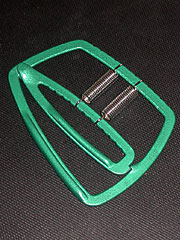 Our home gym has a small but respectable collection of grip tools. A few Iron Mind
Our home gym has a small but respectable collection of grip tools. A few Iron Mind 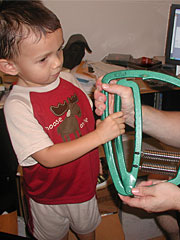
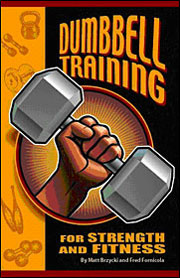
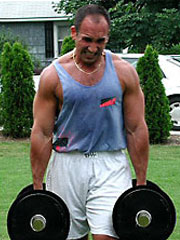 Drew Baye: With so many informercials hyping “high-tech” exercise gadgets and various self-proclaimed fitness gurus concocting and promoting needlessly complex training methods, do you think people need to be reminded they can get great results with very basic equipment and routines?
Drew Baye: With so many informercials hyping “high-tech” exercise gadgets and various self-proclaimed fitness gurus concocting and promoting needlessly complex training methods, do you think people need to be reminded they can get great results with very basic equipment and routines? Drew Baye: Looks like a solid routine. I’ll have to work that into her routine rotation. Speaking of women and training, what are your thoughts on the increasing popularity of resistance training among women?
Drew Baye: Looks like a solid routine. I’ll have to work that into her routine rotation. Speaking of women and training, what are your thoughts on the increasing popularity of resistance training among women?